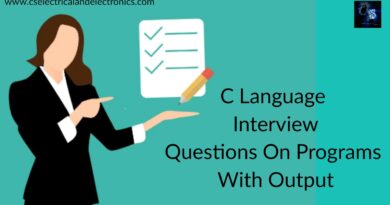Top And Bottom Cell Balancing Using A Flyback Converter Balancing
Hello guys, welcome back to my blog. In this article, I will discuss the top and bottom cell balancing using a flyback converter balancing system, what is top cell balancing, what is bottom cell balancing, top and bottom cell balancing in MATLAB Simulink, etc.
If you have any doubts related to electrical, electronics, and computer science, then ask questions.
Also, read:
- Highest Paying Jobs For Electronics Engineers, Electronics Engineer Jobs
- Types Of Sensors Used In Mobile Phones, Sensors Used In Android Phones
- Applications Of IoT, Internet Of Things, What Is IoT, Latest Technology
Top And Bottom Cell Balancing
Consider the three-battery model as shown in fig. 3.6. Each battery is connected to the secondary winding of the transformer with the help of a switch. The primary winding is connected to the main switch, which is powered by a pulse generator. To perform balancing operations during both charging and discharging, the transformer chosen is bidirectional.
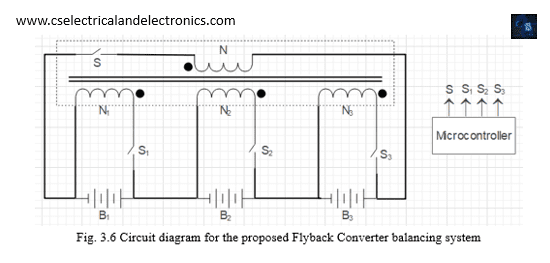
Consider battery B3 to be the weakest battery in the pack. B3 charges and discharges the quickest among all the batteries. Keeping this in mind, the working of the model can be explained in two modes:
What Is Top Balancing?
Top Balancing (Charging Mode): During charging a difference in the SoC values between B3 and the other batteries is observed, which becomes prominent when batteries are close to their CVL. It is easily noticeable that B3 has the highest SoC. To equalize the SoCs, the balancing topology transfers energy from B3 to the other batteries.
As a result, batteries B1 and B2 are charged not only by the voltage source but also by the energy received from B3. Thus, the energy of B3 decreases. This process continues till all the batteries have the same SoC, post which the normal charging process continues.
What Is Bottom Balancing?
Bottom Balancing (Discharging Mode): Similar to the charging mode, during discharging a difference in the SoC values between B3 and the other batteries is observed, which becomes prominent when batteries are close to their DVL. It is easily noticeable that B3 has the lowest SoC. To equalize the SoCs, the balancing topology transfers energy from all the batteries to B3.
As a result, batteries B1 and B2 discharge faster. Since B3 receives energy from the battery pack, the net discharge rate is slow. Thus, the energy of batteries B1 and B2 decreases more quickly than B3. This process continues till all the batteries have the same SoC, post which the normal discharging process continues.
Assumptions Made
For simulating the above circuit, the following assumptions were made:
- Assumptions made during design:
- Switches, used in place of MOSFETs are ideal.
- The initial current of the inductor and initial voltage of the capacitor was 0.
- The flyback converter always operates in the continuous current mode.
Assumptions made during simulation:
- For the battery, temperature and aging effects were not simulated.
- There was no voltage drop across the switches i.e., they were ideal.
- The transformer windings were not tapped, the core was not saturated and the winding resistance was zero.
Design and Modelling Of Top And Bottom Cell Balancing In MATLAB Simulink
To verify the circuit operation, it was simulated in the Simulink platform. At every interval, the highest and lowest SoC is recorded. Since the topology is in action only when CVL and DVL are close by, the circuit is designed such that top balancing starts when at least one battery has SoC above or equal to 90% and bottom balancing starts when at least one battery has SoC below or equal to 10%. An or-gate activates the circuit when either of the states is in action. Based on this, the following circuit was designed.
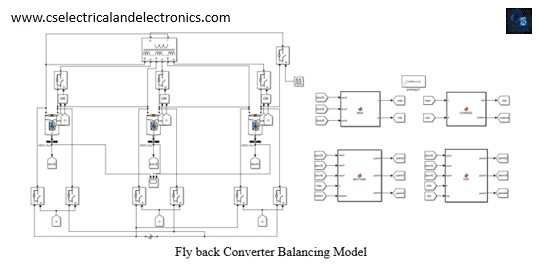
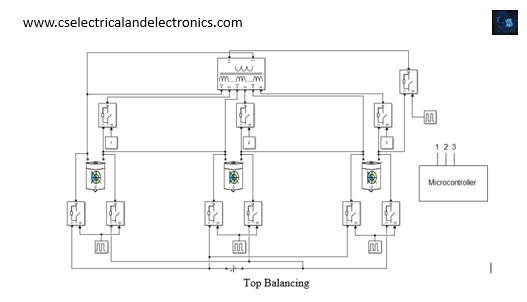
The working of this technique in the top balancing mode can be understood from fig. The limit near CVL, from where the balancing operation will take place is set at 90%. If any battery has SoC greater than or equal to 90%, this stage is applied. As a result, the batteries having higher SoC transfer energy to the battery having the lowest SoC. In this way, the strongest battery is supported. This process continues till all the batteries have equal SoC. The DC voltage source provides charge to the batteries during the charging process. The entire operation is controlled by the microcontroller.
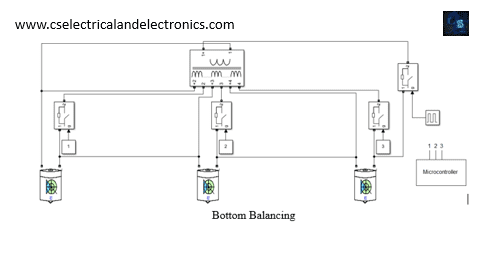
The working of this technique in the bottom balancing mode can be understood from fig. The limit near DVL, from where the balancing operation will take place is set at 10%. If any battery has SoC lesser than or equal to 10%, this stage is applied. As a result, the batteries having higher SoC transfer energy to the battery having the lowest SoC. In this way, the weakest battery is supported. This process continues till all the batteries have the same SoC. It is controlled by the microcontroller too.
Waveforms Of Top & Bottom Cell Balancing
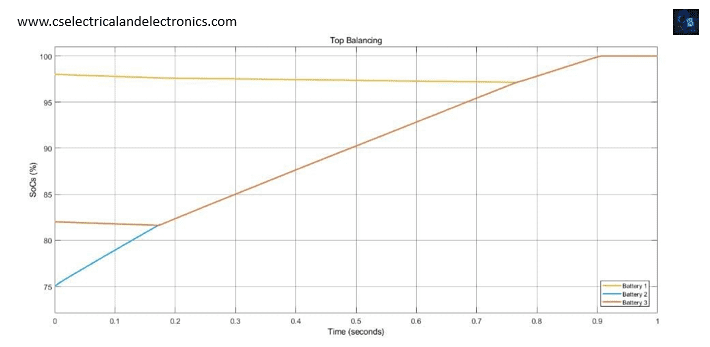
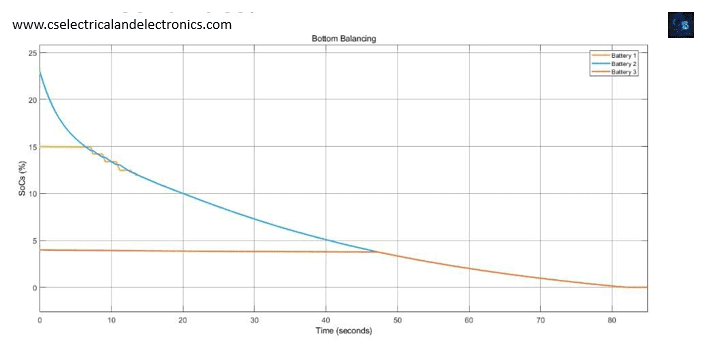
Module Specifications
- Powergui: Simulation Type: Continuous
- Pulse Generator: A pulse generator having switching frequency fs 47kHz, amplitude 1, and pulse width 48%.
- Switches: Ideal switches, each having internal resistance Ron of 0.001Ω. All switches are initially open. Each switch has a snubber resistance of Rs of 100kΩ and infinite snubber capacitance Cs.
- Multi-Winding Transformer: A transformer having one primary winding and three secondary windings.
- Batteries: Each battery has a nominal voltage of 3.7V and a capacity 2Ah. Table 2 gives the initial SoCs for three batteries during top balancing. Table 3 gives the initial SoCs for three batteries during bottom balancing.

- Logic Gate: OR logic gate.
- Voltage Source: A DC voltage source of 100V.
- MATLAB Functions: Functions to design the microcontroller.
- Gotos-Froms: To facilitate the use of SoC and triggering pulses with MATLAB functions.
- Bus Selectors: To get the SoC of each battery.
- Scope: To view the SoCs during the entire balancing process
Module Justifications
The powergui block is essential to obtain a continuous solution i.e., to see the output of the circuit at every interval. Moreover, this block allows us to use the Simscape Electrical Specialised Power Systems tools.
The pulse generator powers the transformer which is the first step in realizing the balancing topology.
The microcontroller is the brain of the balancing system. It makes a note of the highest and lowest SoC in the battery and accordingly implements top or bottom balancing. If the SoCs are neither near CVL nor DVL, this balancing topology does not operate. Various gotos-from blocks make the circuit clutter-free.
The ideal switches eliminate switching losses and reduce the EMI effect due to soft switching. They work according to the command passed onto them by the microcontroller.
The transformer facilitates the transfer of energy by coupling, from one battery to the other. Due to its bidirectional nature, the same transformer can be used in both balancing states.
The batteries considered in the topology have unequal SoCs and therefore, need to be balanced. The OR logic gates implement either of the two working stages of the topology.
The DC voltage source, used only during top balancing, helps in the charging process. The batteries take charge from here to reach CVL.
From the measuring node of the battery, voltage, current, and SoC can be shown in a graph. Since the balancing has been performed based on the SoC values of the battery, it is desired to observe the graph of SoC only during simulation. Bus selectors help in filtering the signals such that only the SoC of the batteries can be visualized.
I hope this article ” Top And Bottom Cell Balancing ” may help you all a lot. Thank you for reading ” Top And Bottom Cell Balancing “.
Also, read:
- 10 Tips To Maintain Battery For Long Life, Battery Maintainance
- 10 Tips To Save Electricity Bills, Save Money By Saving Electricity
- 100 (AI) Artificial Intelligence Applications In The Automotive Industry
- 100 + Electrical Engineering Projects For Students, Engineers
- 1000+ Control System Quiz, Top MCQ On Control System
- 1000+ Electrical Machines Quiz, Top MCQs On Electrical Machines
- 1000+ Electronics Projects For Engineers, Diploma, MTech Students
- 1000+ MATLAB Simulink Projects For MTech, Engineering Students
Author Profile
- Chetu
- Interest's ~ Engineering | Entrepreneurship | Politics | History | Travelling | Content Writing | Technology | Cooking
Latest entries
 All PostsApril 29, 2024Top 11 Free Courses On Battery For Engineers With Documents
All PostsApril 29, 2024Top 11 Free Courses On Battery For Engineers With Documents All PostsApril 19, 2024What Is Vector CANoe Tool, Why It Is Used In The Automotive Industry
All PostsApril 19, 2024What Is Vector CANoe Tool, Why It Is Used In The Automotive Industry All PostsApril 13, 2024What Is TCM, Transmission Control Module, Working, Purpose,
All PostsApril 13, 2024What Is TCM, Transmission Control Module, Working, Purpose, All PostsApril 12, 2024Top 100 HiL hardware in loop Interview Questions With Answers For Engineers
All PostsApril 12, 2024Top 100 HiL hardware in loop Interview Questions With Answers For Engineers







